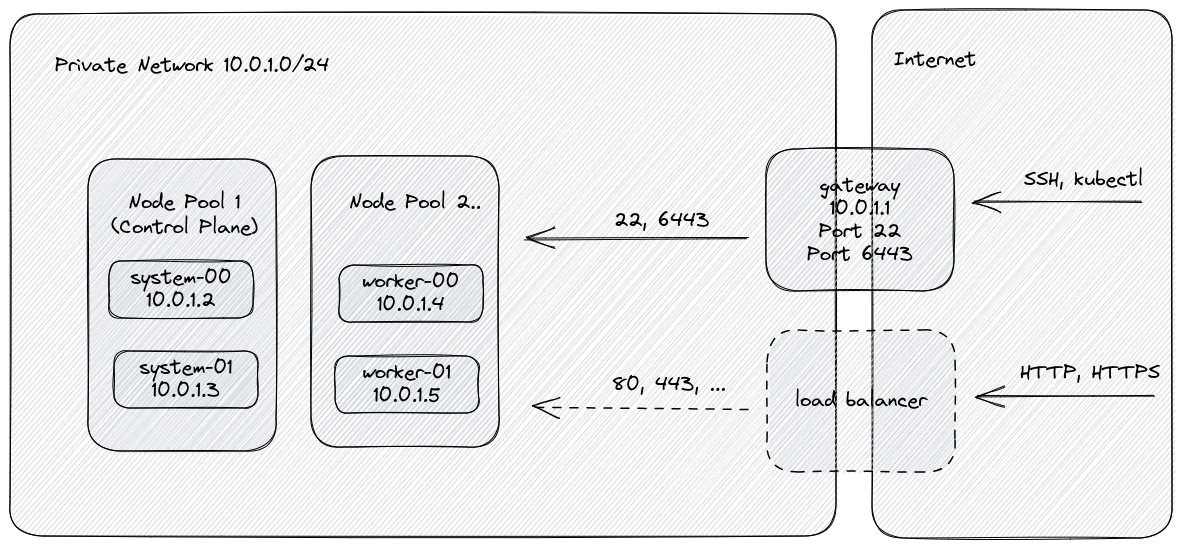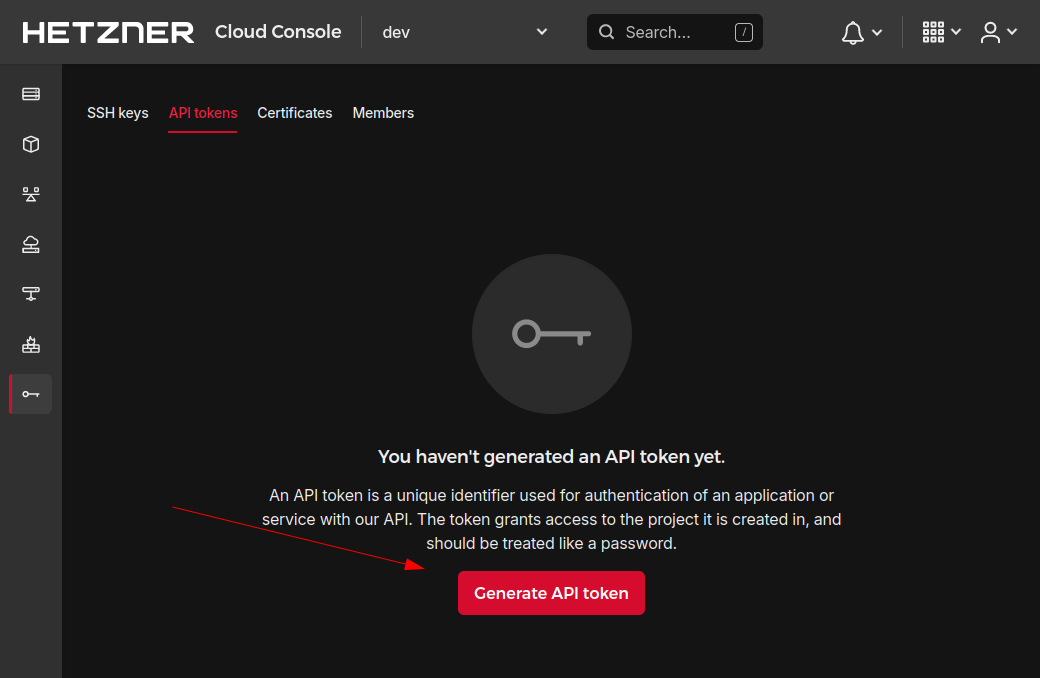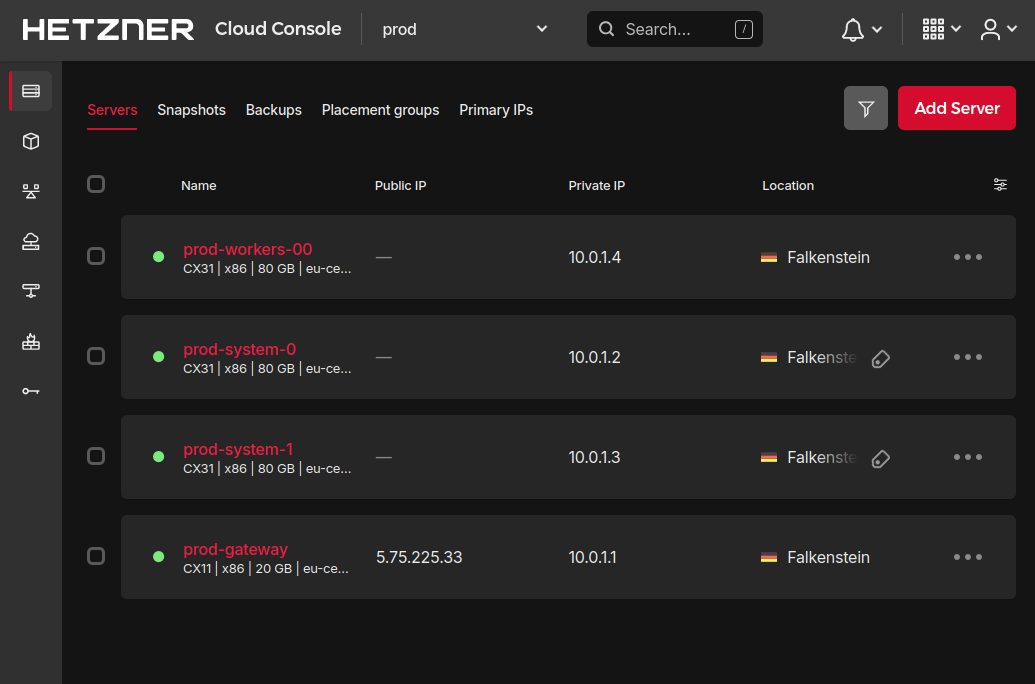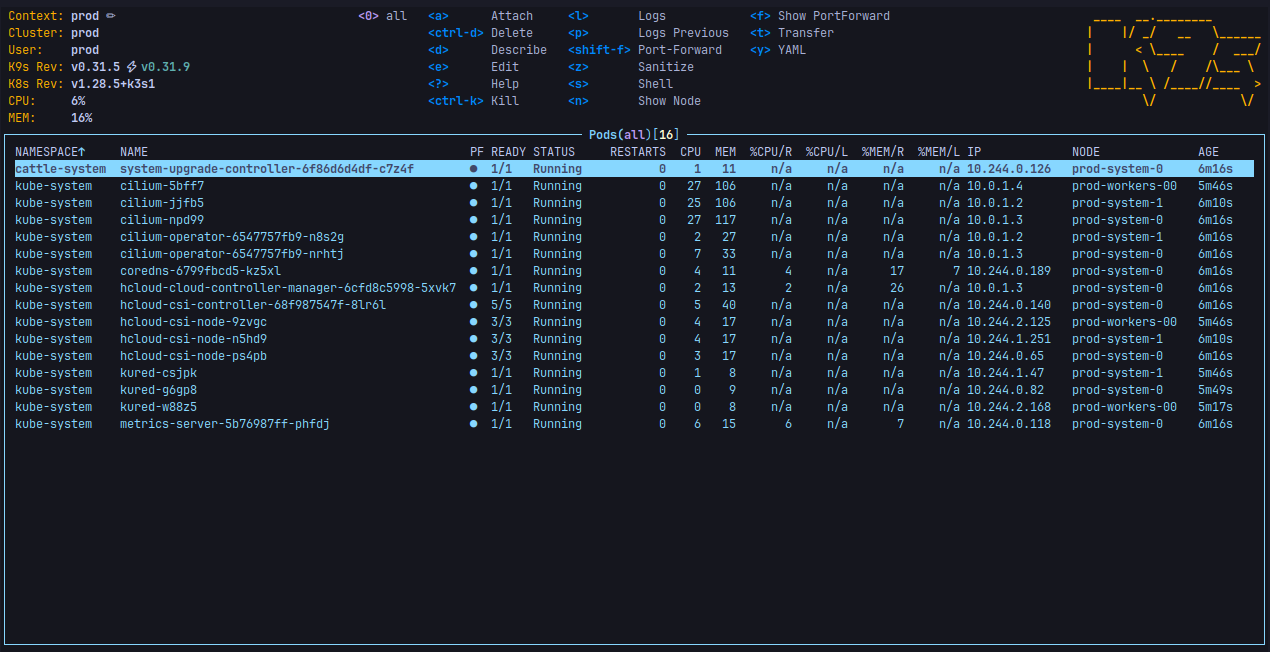This Terraform module creates a Kubernetes Cluster on Hetzner Cloud infrastructure running Ubuntu 24.04. The module aims to be simple to use while providing an out-of-the-box secure and maintainable setup. Thanks to Ubuntu's LTS version we get up to 5 years of peace and quiet before having to upgrade the cluster's operating system!
Module published at:
- Terraform registry: https://registry.terraform.io/modules/identiops/k3s/hcloud
- OpenTofu registry: https://search.opentofu.org/module/identiops/k3s/hcloud
What changed in the latest version? See CHANGELOG.md.
- k3s based Kubernetes cluster.
- Node pools for managing cluster resources efficiently. Pools can be added, resized, and removed at any time.
- Automated Kubernetes update management via System Upgrade Controller.
- Automated operating system updates with automatic system reboots via kured.
- Embedded container registry mirror for fast pod startup times across nodes.
- Private registry configuration to avoid manual configuration of pull secrets.
- Creation of placement groups for to improve availability.
- Multi-region deployments.
- Secured default configuration:
- Deletion protection for all cloud resources.
- SSH key required for remote access.
- fail2ban limits SSH brute force attacks.
- Cluster nodes have no public network interface.
- Internal firewall active on all nodes for minimal exposure.
- Support for network policies via Cilium.
- CSI hardening guide applied:
- Kernel parameters defined.
- Audit log directory created.
- Network policies, pod security policies, admission policies and the enabling of audit logs are up to the administrator of the cluster to configure.
- Integration of Hetzner Cloud Controller Manager for managing cloud resources from the within the cluster.
- Integration of Hetzner Cloud Storage Interface for managing volumes from the within the cluster.
- Ansible integration with automatically generated inventory.
- Convenience scripts for retrieving the Kubernetes configuration and accessing nodes via SSH and SCP.
- Calculation of monthly costs for every part of the deployment (see terraform output).
- Documentation of common administrative tasks and troubleshooting approaches.
- OIDC support for user authentication. Some configuration is in place, but it hasn't been tested, yet.
- Support for cluster auto scaler.
- Getting Started
- Configuration
- Maintenance
- Access Kubernetes API via Port-Forwarding from Gateway
- Ansible: Execute Commands on Nodes
- Add Ingress Controller and Load Balancer
- Add Nodes or Node Pools
- Remove Nodes or Node Pools
- Stop Automated Node Reboots
- Upgrade Operating System
- Update Kubernetes
- Update Cilium
- Update Hetzner Cloud Controller Manager (CCM)
- Update Hetzner Cloud Storage Interface (CSI)
- Update Kured
- Update Metrics Server
- Update System Upgrade Controller
- Deletion
- Troubleshooting
- Related Documentation
- Similar Projects
- Special Thanks
WARNING: Apple Silicon is apparently not supported by important terraform modules, see #19.
- Terraform or OpenTofu. Note that you'll need Terraform v1.0 or newer to run this project.
- bash for executing the generated scripts.
- jq for executing the generated scripts.
- kubectl for interacting with the Kubernetes cluster.
- ssh for connecting to cluster nodes.
- Ansible cli for executing commands simultaneously on multiple cluster nodes.
- Cilium cli for verifying and interacting with the Kubernetes networking layer.
- Helm cli for installing and updating components inside the cluster.
- Create a Hetzner Cloud API token.
- Register with Hetzner Cloud.
- Create a new project.
- Navigate to the security settings.
- Select the "API tokens" tab and add a new token with read & write access and a second token with just read access.
- Store Hetzner Cloud API token locally. Either, pass the tokens to terraform via an environment variable or create a file called terraform.tfvars:
- Download examples/1Region_3ControlPlane_3Worker_Nodes/main.tf: curl -LO https://github.com/identiops/terraform-hcloud-k3s/raw/main/examples/1Region_3ControlPlane_3Worker_Nodes/main.tf
- Adjust the cluster configuration in main.tf, e.g.
- cluster_name
- default_location
- k3s_version
- ssh_keys (to create a new ssh key run: ssh-keygen -t ed25519)
- node_pools
- More options described in section Configurtion
- For multi-region deployments, there are a few things to consider:
- It is recommended to distribute the control plane nodes across multiple regions. If 3 control plane nodes shall be used, create 3 node pools and configure a different location for each pool.
- etcd's default configuration expects a low-latency local network. When distributing nodes across multiple regions, latency will increase. The timing parameters therefore need to be adjusted, see etcd Tuning. Set control_plane_k3s_additional_options, e.g. to --etcd-arg=heartbeat-interval=120 --etcd-arg=election-timeout=1200 Measurements between Falkenstein, Nuremberg and Helsinki: I measured a latency of 0.7ms (within Nuremberg region), 3ms (Nuremberg -> Falkenstein), and 24ms (Nuremberg -> Helsinki).
- Hetzner doesn't support mounting volumes on servers in another region! The most simple setup is to just distribute the control plane nodes across multiple regions, disable the scheduling of workloads on control plane nodes and keep all worker nodes pools within one region. For better availability of workloads, worker node pools should be distributed across regions. This requires a configuration of taints and tolerations and node affinity to ensure that pods with volumes are schedules in the correct region.
- Depending on the selected server regions the network_zone setting should be adjusted.
- Hetzner's load balancers are bound to one region. Therefore, a multi-regional cluster with one load balancer is not sufficent for dealing with zone outages. The load balancer would go down with the region it's hosted in. If a protection against zone outages is required, a global load balancer should be deployed elsewhere, as described by Google.
- Initialize the configuration: terraform init
- Apply the configuration: terraform apply
- Grab a coffee and enjoy the servers popping up in Hetzner's cloud console. Wait for about 5 minutes.
- Test SSH access to the cluster: ./ssh-node cluster
- ATTENTION: don't hammer the cluster with failing SSH requests, or you'll be banned by your cluster automatically! If the request fails, because the cluster node isn't ready yet, wait another minute.
- Once SSH connection is established, double check that everything is working
as expected:
- Did the node initialization finish successfully? cloud-init status
- Is the cluster up and running? kubectl cluster-info
- If the tests were successful, retrieve the Kubernetes configuration and store it locally: ./setkubeconfig
- Forward the cluster port locally since it's not exposed to the Internet by default. Do this every time you want to interact with the cluster: ./ssh-node gateway
- On your local machine test cluster access: kubectl get nodes
Enjoy your new cluster! 🚀
Start using your favorite Kubernetes tools to interact with the cluster. One of the first steps usually involves deploying an ingress controller since this configuration doesn't ship one.
In addition, a few convenience scripts were created to help with maintenance:
- setkubeconfig: retrieves and stores the Kubernetes configuration locally.
- unsetkubeconfig: removes the cluster from the local Kubernetes configuration.
- ls-nodes: lists the nodes that are part of the cluster for access via ssh-node and scp-node.
- ssh-node: SSH wrapper for connecting to cluster nodes.
- scp-node: SCP wrapper for connecting to cluster nodes.
- .ssh/config: SSH configuration for connecting to cluster nodes.
- .ansible/hosts: Ansible hosts configuration for executing commands on multiple nodes in parallel.
- Add an "s3" backend section to main.tf, with the appropriate parameters. See example below for Wasabi.
- Set access key id and access key in environment variables AWS_ACCESS_KEY_ID and AWS_SECRET_ACCESS_KEY.
- Reconfigure terraform: terraform init -reconfigure
- Extend main.tf with the following variables:
- Set the following module parameters before initializing the cluster's control plane nodes:
- Etcd will automatically create a snapshot every day and keep it for three days.
TODO: add example
- Ensure cryptsetup is installed on all nodes. By default it is installed.
- Encryption is configured per StorageClass.
- Follow the instructions at hcloud-csi Volumes Encrypted with LUKS to create a secret and link it to a storage class.
- All future volumes created with this StorageClass will be encrypted.
- Sysctl paramerts can be adjusted if needed via the sysctl_settings variable.
- Caution is advised!
- A common issue are truncated kubectl log outputs when the variables fs.inotify.max_user_instances and fs.inotify.max_user_watches are set too low. The values are increased by the default configuration. Furthere adjustments might be needed.
Usually, pull secrets need to be configured to access container images stored in private registries. This terraform module provides access to k3s' Private Registry Configuration.
Add a private registry configuration with the following setting:
By default, the Kubernetes API port is not exposed on the internet, see option gateway_firewall_k8s_open. Therefore, it is required to forward the Kubernetes API port 6443 from the gateway.
A limited account kubeapi was created on the gateway that restricts SSH keys configured via option ssh_keys_kubeapi to forward the single port. A corresponding SSH config entry is created. The following command connects to the gateway with the restricted user account:
With the established connection and a proper KUBECONFIG, the cluster can be accessed:
This module automatically generates an Ansible inventory in file .ansible/hosts. It can be leveraged to interact with the nodes and node pools of the cluster.
Example: Execute a command on all control plane nodes
Since this module doesn't ship an ingress controller, one of the first configurations applied to the cluster is usually an ingress controller. Good starting points for an ingress controller are:
The ingress controller, like the rest of the cluster, is not directly exposed to the Internet. Therefore, it is necessary to add a load balancer that is directly exposed to the Internet and has access to the local network of the cluster. The load balancer is added to the cluster simply by adding annotations to the ingress controller's service. Hetzner's Cloud Controller Manager will use the annotations to deploy and configure the load balancer.
The following annotations should be used:
- Resource name: load-balancer.hetzner.cloud/name: "ingress-lb"
- Protocol, just tcp - the ingress controller will take care of the HTTP connection: load-balancer.hetzner.cloud/protocol: "tcp"
- Location, same as the one used for the cluster: load-balancer.hetzner.cloud/location: "nbg1"
- Connection to the servers, must be set to true: load-balancer.hetzner.cloud/use-private-ip: "true"
- Size, see options: load-balancer.hetzner.cloud/type: "lb11"
- See list of all supported Load Balancer Annotations.
Furthermore, for domain names to work, it is required to point DNS records to the IP address of load balancer. external-dns is a helpful tool that can automate this task from within the cluster. For this to work well with Ingress resources, the ingress controller needs to expose the published service information on the Ingress resources.
The number of nodes in a node pool can be increased at any point. Just increase the count and apply the new configuration via terraform apply. After a few minutes the additional nodes will appear in the cluster.
In the same way, node pools can be added to the configuration without any precaution.
Removing nodes requires the following steps:
- Identify the nodes and node pools that shall be removed. If the number of nodes in a node pool needs to be decreased, the nodes will be removed from the highest to the lowest number. Example: when the number of nodes in pool system is decreased from 3 to 2, node cluster-system-02 will be removed and nodes cluster-system-01 and cluster-system-00 will remain.
- Drain all nodes that will be removed of pods: kubectl drain cluster-system-02
- Wait until all pods have been migrated to other nodes before continuing.
- If you drained the wrong node, you can reactivate the node with: kubectl uncordon cluster-system-02
- Update the terrafrom configuration and apply it: terraform apply
- Review the plan to verify that the drained nodes will be deleted.
- Delete nodes from cluster: kubectl delete node cluster-system-02
Nodes are rebooting automatically when they receive updates that require a reboot. The kured service triggers reboots of nodes one by one. Reboots can be disabled system-wide by annotating the Daemonset, see https://kured.dev/docs/operation/.
An operating system update is not recommended, e.g. from Ubuntu 22.04 to 24.04. Instead, the corresponding nodes should be replaced!
- Set new image as default_image. Attention: before changing the default image, make sure that each node pool has its own appropriate image setting.
- Delete the node in the Hetzner Console
- Reapply the configuration: terraform apply
The gateway will reappear again within a few minutes. This will disrupt the Internet access of the cluster's nodes for tasks like fetching package updates. However, it will not affect the services that are provided via load balancers!
After redeploying the gateway, ssh connections will fail because a new cryptographic has been generated for the node. Delete the deprecated key from the .ssh/known_hosts file, open a new ssh connection and accept the new public key.
Nodes should not be updated manually via agt-get, but be replaced. For control plane nodes, it is recommended to create a back-up of the etcd data store on an external s3 storage, see k3s Cluster Datastore.
- For control plane pools only: Create a new etcd snapshot, see k3s etcd-snapshot.
- Then, perform the following steps on consecutively on all existing node pools until they have all been replaced.
Start the replacement with the node pool with the cluster_can_init setting:
- Ensure that there's another control plane node pool. If there's no other control plane node pool, create a temporary one that is deleted after the successful replacement of the node pool with the cluster_can_init setting.
- When the second control plane node pool is up and running, the node pool with
the cluster_can_init setting must be deleted and replaced in one
application of the configuration.
- Ensure that the cluster_init_action.init and cluster_init_action.reset settings are disabled.
- Drain the old nodes: kubectl drain node-xyz
- Once all pods have been migrated, delete the old nodes: kubectl delete node node-xyz
- Then rename the node pool to achieve deletion and replacement in one configuration change.
- Apply the configuration: terraform apply
- Once the new control plane node pool with the cluster_can_init setting is again up and running, the temporary control plane node pool can be deleted.
Perform these steps for all remaining node pools:
- Add a new node pool and set the image setting to the new version.
- Once the new node pool is up and running, drain the old nodes: kubectl drain node-xyz
- Once all pods have been migrated, delete the old nodes: kubectl delete node node-xyz
- Remove the node pool from the terraform configuration.
- Reapply the configuration: terraform apply
- Determine the next Kubernetes version, see k3s channels, k3s images tags, and k3s upgrade image tags.
- Write the upgrade plan, see instructions and examples.
- Apply an upgrade plan.
- Update the image variable in the configuration for future nodes to be deployed with the correct image.
Example upgrade plan:
- Available versions: https://github.com/cilium/cilium
- Update instructions: https://docs.cilium.io/en/stable/operations/upgrade/
values.yaml:
- Available versions: https://github.com/hetznercloud/hcloud-cloud-controller-manager#versioning-policy
- Update instructions: https://github.com/hetznercloud/hcloud-cloud-controller-manager/blob/main/CHANGELOG.md
values.yaml:
- Available versions: https://github.com/hetznercloud/csi-driver/blob/main/docs/kubernetes/README.md#versioning-policy
- Update instructions: https://github.com/hetznercloud/csi-driver/blob/main/CHANGELOG.md
values.yaml:
- Available versions: https://artifacthub.io/packages/helm/kured/kured
- Update instructions: https://github.com/kubereboot/kured
values.yaml:
- Available versions: https://artifacthub.io/packages/helm/metrics-server/metrics-server
- Update instructions: https://github.com/kubernetes-sigs/metrics-server
values.yaml:
- Available versions: https://github.com/rancher/charts/tree/release-v2.10/charts/system-upgrade-controller
- Update instructions: https://github.com/rancher/system-upgrade-controller
values.yaml:
After applying the Terraform plan you'll see several output variables like the load balancer's, control plane's, and node pools' IP addresses.
Be sure to clean up any CSI created Block Storage Volumes, and CCM created LoadBalancers that you no longer require.
Ensure gateway is set up correctly: ./ssh-node gateway
Ensure cluster is set up correctly: ./ssh-node cluster
This command only works after installing the cilium cli.
This command only works out of the box on the first node of the control plane node pool with the cluster_can_init setting.
- hcloud-kube-hetzner very popular k3s stack based on openSUSE MicroOS.
- hcloud-k3s Original project that this project has been forked from.
- hetzner-cloud-k3s A fully
functional, super cheap Kubernetes cluster in Hetzner Cloud in 1m30s or less
- Not terraform-based.
- Scripts that make it easy to manage a cluster.
- hetzner-k3s A CLI tool to create
and manage Kubernetes clusters in Hetzner Cloud using the lightweight
distribution k3s by Rancher. Successor of
hetzner-cloud-k3s.
- Not terraform-based.
- k-andy Zero friction Kubernetes stack
on Hetzner Cloud.
- Terraform-based stack.
- Distributed across multiple Hetzner sites and data centers.
- Support for multiple control-plane servers.
- terraform-hcloud-kube-hetzner. Optimized and Maintenance-free Kubernetes on Hetzner Cloud in one command!
- The initiators of and contributors to this project for getting the k3s cluster running via terraform.
- And to God for providing and enabling me to do my share of this work. Solo Deo Gloria.
.png)










